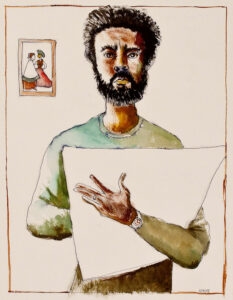The multi-talented African American poet, novelist and artist Clarence Major spent some time at Lake Chapala in 1968.
Major was born in Atlanta, Georgia, in 1936 and grew up in Chicago. In the early 1950s, Major studied drawing and painting under painter Gus Nall (1919–1995) and attended the Art Institute of Chicago, where his teachers included Addis Osborne (1914–2011). Coincidentally, the enigmatic African American artist Ernest Alexander, who lived for several years in Ajijic in the early 1950s, had also studied in Chicago and exhibited at the Art Institute of Chicago shortly before Major took classes there.
In 1966, after two marriages which both ended in divorce, Major moved to New York to begin a distinguished teaching career. Over the next 30 years, he taught creative writing and/or literature classes at Brooklyn College, Queens College, Sarah Lawrence College, University of Washington, Howard University, University of Maryland, University of Colorado, Temple University, and the State University of New York (Binghamton). In 1989, Major moved to California, where he taught until his retirement in 2007 at the University of California at Davis.
In 1968, Major left New York and visited Mexico for several months in the company of his then girlfriend Sheila Silverstone. During the trip, Major was revising his first novel, All Night Visitors, published in 1969. Major’s first collection of poems, Swallow the Lake, was published the following year and won a National Council on the Arts Award.
In Mexico, the couple spent some time in Puerto Vallarta but also visited Lake Chapala, which became the basis for at least two poems published in Symptoms & madness: poems (1971).
The first poem is entitled “IN CHAPALA, JAL” and describes them sitting, reading, in “a red mud / colored 30 pesos per day hotel room”.
The second poem, entitled “EIGHTEEN-DOLLAR TAXI TRIP TO TIZAPAN AND BACK TO CHAPALA” was later included in the collection Configurations: New & Selected Poems, 1958-1998, published in 1999 and a finalist for a 1999 National Book Award. This poem tells how their taxi driver (“with a good life / who has four children, / a pregnant wife, / and who lives in Guadalajara”) drives them, “radio going / cha-cha-cha” through a storm around the south side of the lake.
Major’s poetry and short stories have been published in dozens of literary magazines and anthologies. Major has won dozens of major awards and served as a judge for many important literary contests including the the PEN/Faulkner Award (1997-1998), the National Endowment for the Arts Awards (1987) and the National Book Awards (1991). Major helped edit several literary periodicals, including Caw! and The Journal of Black Poetry. He was a regular columnist for American Poetry Review and the first editor of American Book Review.
In 2015, Major was awarded the “Lifetime Achievement Award in the Fine Arts,” by The Congressional Black Caucus Foundation.
Major’s novels include All-Night Visitors (1969); No (1973); Reflex and Bone Structure (1975; Emergency Exit (1979); My Amputations (1986); Such Was The Season (1987); Painted Turtle: Woman With Guitar (1988); Dirty Bird Blues (1996); and One Flesh (2003).
His poetry works include Swallow The Lake (1970); Symptoms & Madness (1971); Private Line (1971); The Cotton Club (1972); The Syncopated Cakewalk (1974); Inside Diameter: The France Poems (1985); Surfaces and Masks (1988); Some Observations of a Stranger at Zuni in The Latter Part of The Century (1989); Parking Lots (1992); Configurations: New and Selected Poems 1958–1998 (1999); Waiting for Sweet Betty (2002); Myself Painting (2008); Down and Up (2013); and From Now On: New and Selected Poems 1970–2015 (2015).
His nonfiction books include Dictionary of Afro-American Slang (1970); The Dark and Feeling: Black American Writers and Their Work (1974); Juba to Jive: A Dictionary of African-American Slang (1994); Necessary Distance: Essays and Criticism (2000); Come by Here: My Mother’s Life (2002); Configurations (2010) and Myself Painting (2011).
In his parallel career as a visual artist, Major’s first solo exhibition of paintings was at Sarah Lawrence College in 1974. Other galleries that have hosted one-person shows of Major’s art include First National Bank Gallery, Boulder, Colorad (1986); Kresge Art Museum, East Lansing, Michigan (2001); Schacknow Museum of Fine Art, Plantation, Florida (2003); Exploding Head Gallery, Sacramento CA (2003, 2004, 2006); Blue Hills Gallery, Winters, CA (2005); Phoenix Gallery, Sacramento CA (2006); Hamilton Club Gallery, Paterson, New Jersey (2007); Pierre Menard Gallery, Harvard Square, Cambridge (2010); and University Art Gallery, Indiana State University, Terre Haute (2011). His work has also featured in numerous group shows in New York, Los Angeles, and Davis, California.
His paintings now hang in many private and public collections, including those at Indiana State University, Terre Haute; Passaic County Community College Permanent Collection of Contemporary Art; the Schacknow Museum of Fine Art, Plantation, Florida; and The Linda Matthews MARBL Collection at Emory University, Atlanta, Georgia.
The covers of several of Major’s books, including Myself Painting, Waiting for Sweet Betty, and Down and Up feature his own paintings.
Works about Clarence Major
His life, art and literature are described by Bernard Bell in Clarence Major and His Art: Portraits of an African-American Postmodernist (1998), by Nancy Bunge in Conversations with Clarence Major (2002) and by Keith Eldon Byerman in The Art and Life of Clarence Major (2016).
Sombrero Books welcomes comments, corrections or additional material related to any of the writers and artists featured in our series of mini-bios. Please email us or use the comments feature at the bottom of individual posts.
Tony Burton’s books include “Lake Chapala: A Postcard History” (2022), “Foreign Footprints in Ajijic” (2022), “If Walls Could Talk: Chapala’s historic buildings and their former occupants” (2020), (available in translation as “Si Las Paredes Hablaran”), “Mexican Kaleidoscope” (2016), and “Lake Chapala Through the Ages” (2008).
